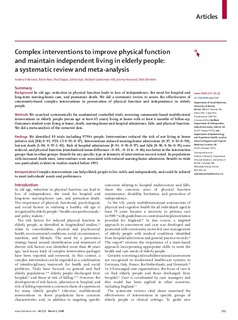| dc.contributor.author | Beswick, A.D. | |
| dc.contributor.author | Rees, K. | |
| dc.contributor.author | Dieppe, P. | |
| dc.contributor.author | Ayis, S. | |
| dc.contributor.author | Gooberman-Hill, R. | |
| dc.contributor.author | Horwood, J. | |
| dc.contributor.author | Ebrahim, S. | |
| dc.date.accessioned | 2018-01-16T10:34:38Z | |
| dc.date.available | 2018-01-16T10:34:38Z | |
| dc.date.issued | 2008 | |
| dc.identifier.citation | Beswick, A.D., Rees, K., Dieppe, P., Ayis, S., Gooberman-Hill, R., Horwood, J. & Ebrahim, S. (2008) Complex interventions to improve physical function and maintain independent living in elderly people: a systematic review and meta-analysis. The Lancet, 371(9614), 725-735. | nb_NO |
| dc.identifier.uri | http://hdl.handle.net/11250/2477746 | |
| dc.description.abstract | Background: In old age, reduction in physical function leads to loss of independence, the need for hospital and long-term nursing-home care, and premature death. We did a systematic review to assess the effectiveness of community-based complex interventions in preservation of physical function and independence in elderly people. Methods: We searched systematically for randomised controlled trials assessing community-based multifactorial interventions in elderly people (mean age at least 65 years) living at home with at least 6 months of follow-up. Outcomes studied were living at home, death, nursing-home and hospital admissions, falls, and physical function. We did a meta-analysis of the extracted data. Findings: We identified 89 trials including 97 984 people. Interventions reduced the risk of not living at home (relative risk [RR] 0·95, 95% CI 0·93–0·97). Interventions reduced nursing-home admissions (0·87, 0·83–0·90), but not death (1·00, 0·97–1·02). Risk of hospital admissions (0·94, 0·91–0·97) and falls (0·90, 0·86–0·95) were reduced, and physical function (standardised mean difference −0·08, −0·11 to −0·06) was better in the intervention groups than in other groups. Benefit for any specific type or intensity of intervention was not noted. In populations with increased death rates, interventions were associated with reduced nursing-home admission. Benefit in trials was particularly evident in studies started before 1993. Interpretation Complex interventions can help elderly people to live safely and independently, and could be tailored to meet individuals' needs and preferences. | nb_NO |
| dc.publisher | The Lancet | nb_NO |
| dc.subject | community-based complex interventions | nb_NO |
| dc.subject | physical function | nb_NO |
| dc.subject | independence | nb_NO |
| dc.subject | elderly people | nb_NO |
| dc.subject | Interpretation Complex interventions | nb_NO |
| dc.subject | intervention | nb_NO |
| dc.title | Complex interventions to improve physical function and maintain independent living in elderly people: a systematic review and meta-analysis | nb_NO |
| dc.type | Journal article | nb_NO |
| dc.source.pagenumber | 725-735 | nb_NO |
| dc.source.volume | 371 | nb_NO |
| dc.source.journal | The Lancet | nb_NO |
| dc.source.issue | 9614 | nb_NO |
| dc.identifier.doi | https://doi.org/10.1016/S0140-6736(08)60342-6 | |
